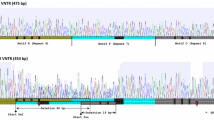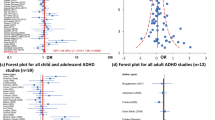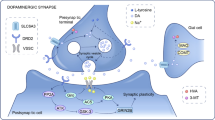Abstract
It is well known that dopaminergic genes affect the development of attention deficit hyperactivity disorder (ADHD) in various populations. Many studies have shown that variable number tandem repeats (VNTRs) located within the 3′-untranslated region of DAT1 and in exon 3 of DRD4 are associated with ADHD development; however, these results were inconsistent. Therefore, we investigated the genetic association between two VNTRs and ADHD in Korean children. We determined the VNTRs using PCR. We examined genotype and allele frequency differences between the experimental and control groups, along with the odds ratios, using Chi square and exact tests. We observed a significant association between the children with ADHD and the control group in the 10R/10R genotype of DAT1 VNTRs (p = 0.025). In addition, the 11R allele of DAT1 VNTRs showed a higher frequency in the control group than in the ADHD group (p = 0.023). Also, the short repeat (without 11R) and long repeat alleles (including 11R) were associated with ADHD (p < 0.05). The analysis of DRD4 VNTRs revealed that the 2R allele is associated with ADHD (p = 0.025). A significant result was also observed in long and short repeats (p < 0.05). Additionally, ADHD subtypes showed that the DRD4 VNTRs are associated with combined and hyperactive-impulsive subtype groups (p < 0.05). Therefore, our results suggest that DAT1 VNTRs and DRD4 VNTRs play a role in the genetic etiology of ADHD in Korean children.
Similar content being viewed by others
References
Albrecht B, Brandeis D, Uebel-von Sandersleben H, Valko L, Heinrich H, Xu X, Drechsler R, Heise A, Kuntsi J, Müller UC et al (2014) Genetics of preparation and response control in ADHD: the role of DRD4 and DAT1. J Child Psychol Psychiatry 55:914–923
American Psychiatric Association Committee on Nomenclature and Statistics (1994) Diagnostic and statistical manual of mental disorders (DSM-IV), 4th edn. American Psychiatric Assocaition Press, Washington, DC
Asghari V, Sanyal S, Buchwaldt S, Paterson A, Jovanovic V, Van Tol HH (1995) Modulation of intracellular cyclic AMP levels by different human dopamine D4 receptor variants. J Neurochem 65:1157–1165
Barkley RA, Murphy K (1998) Attention-deficit hyperactivity disorder: a clinical workbook, 2nd edn. Guilford Press, New York
Bhaduri N, Das M, Sinha S, Chattopadhyay A, Gangopadhyay PK, Chaudhuri K, Singh M, Mukhopadhyay K (2006) Association of dopamine D4 receptor (DRD4) polymorphisms with attention deficit hyperactivity disorder in Indian population. Am J Med Genet B 141B:61–66
Bidwell LC, Willcutt EG, McQueen MB, DeFries JC, Olson RK, Smith SD, Pennington BF (2011) A family based association study of DRD4, DAT1, and 5HTT and continuous traits of attention-deficit hyperactivity disorder. Behav Genet 41:165–174
Cheuk DK, Li SY, Wong V (2006) Exon 3 polymorphisms of dopamine D4 receptor (DRD4) gene and attention deficit hyperactivity disorder in chinese children. Am J Med Genet B 141B:907–911
Cornish KM, Manly T, Savage R, Swanson J, Morisano D, Butler N, Grant C, Cross G, Bentley L, Hollis CP (2005) Association of the dopamine transporter (DAT1) 10/10-repeat genotype with ADHD symptoms and response inhibition in a general population sample. Mol Psychiatry 10:686–698
DuPaul GJ, Anastopoulos AD, McGoey KE, Power TJ, Reid R, Ikeda MJ (1997) Teacher ratings of attention deficit hyperactivity disorder symptoms: factor structure and normative data. Psychol Assess 9:436–444
Efimova EV, Gainetdinov RR, Budygin EA, Sotnikova TD (2016) Dopamine transporter mutant animals: a translational perspective. J Neurogenet 30:5–15
Erdfelder E, Faul F, Buchner A (1996) GPOWER: a general power analysis program. Behav Res Methods 28:1–11
Fuke S, Suo S, Takahashi N, Koike H, Sasagawa N, Ishiura S (2001) The VNTR polymorphism of the human dopamine transporter (DAT1) gene affects gene expression. Pharmacogenomics J 1(2):152–156
Gadow KD, Roohi J, DeVincent CJ, Hatchwell E (2008) Association of ADHD, tics, and anxiety with dopamine transporter (DAT1) genotype in autism spectrum disorder. J Child Psychol Psychiatry 49:1331–1338
Gaub M, Carlson CL (1997) Behavioral characteristics of DSM-IV ADHD subtypes in a school-based population. J Abnorm Child Psychol 25:103–111
Gornick MC, Addington A, Shaw P, Bobb AJ, Sharp W, Greenstein D, Arepalli S, Castellanos FX, Rapoport JL (2007) Association of the dopamine receptor d4 (DRD4) gene 7-repeat allele with children with attention deficit/hyperactivity disorder (adhd) an update. Am J Med Genet B 144B:379–382
Hasler R, Salzmann A, Bolzan T, Zimmermann J, Baud P, Giannakopoulos P, Perroud N (2015) DAT1 and DRD4 genes involved in key dimensions of adult ADHD. Neurol Sci 36:861–869
Hawi Z, Cummins TD, Tong J, Johnson B, Lau R, Samarrai W, Bellgrove MA (2015) The molecular genetic architecture of attention deficit hyperactivity disorder. Mol Psychiatry 20:289–297
Holmes J, Payton A, Barrett JH, Hever T, Fitzpatrick H, Trumper AL, Harrington R, McGuffin P, Owen M, Ollier W et al (2000) A family-based and case-control association study of the dopamine D4 receptor gene and dopamine transporter gene in attention deficit hyperactivity disorder. Mol Psychiatry 5:523–530
Hong EP, Park JW (2012) Sample size and statistical power calculation in genetic association studies. Genomics Inform 10:117–122
Hou QF, Li SB (2009) Potential association of DRD2 and DAT1 genetic variation with heroin dependence. Neurosci Lett 464:127–130
Kim YS, So YK, Noh JS, Ko SG, Koh YJ (2002) The reliability and validity of Korean parent and teacher ADHD rating scale. J Korean Neuropsychiatr Assoc 41:283–289
Kim YS, Leventhal BL, Kim SJ, Kim BN, Cheon KA, Yoo HJ, Kim SJ, Badner J, Cook EH (2005) amily-based association study of DAT1 and DRD4 polymorphism in Korean children with ADHD. Neurosci Lett 390:76–181
Kim SJ, Kim YS, Kim CH, Lee HS (2006) Lack of association between polymorphisms of the dopamine receptor D4 and dopamine transporter genes and personality traits in a Korean population. Yonsei Med J 47:787–792
Klein M, Onnink M, van Donkelaar M, Wolfers T, Harich B, Shi Y, Dammers J, Arias-Va Squez A, Hoogman M, Franke B (2017) Brain imaging genetics in ADHD and beyond—mapping pathways from gene to disorder at different levels of complexity. Neurosci Biobehav Rev 80:115–155
Kooij JJ, Michielsen M, Kruithof H, Bijlenga D (2016) ADHD in old age: a review of the literature and proposal for assessment and treatment. Expert Rev Neurother 16:1371–1381
Kustanovich V, Ishii J, Crawford L, Yang M, McGough JJ, McCracken JT, Smalley SL, Nelson SF (2004) Transmission disequilibrium testing of dopamine-related candidate gene polymorphisms in ADHD: confirmation of association of ADHD with DRD4 and DRD5. Mol Psychiatry 9:711–717
Kwon HJ, Jin HJ, Lim MH (2014) Association between monoamine oxidase gene polymorphisms and attention deficit hyperactivity disorder in Korean children. Genet Test Mol Biomark 18:505–509
Lahey BB, Pelham WE, Stein MA, Loney J, Trapani C, Nugent K, Kipp H, Schmidt E, Lee S, Cale M et al (1998) Validity of DSM-IV attention-deficit/hyperactivity disorder for younger children. J Am Acad Child Adolesc Psychiatry 37:95–702
Lee HJ, Lee HS, Kim YK, Kim L, Lee MS, Jung IK, Suh KY, Kim S (2003) D2 and D4 dopamine receptor gene polymorphisms and personality traits in a young Korean population. Am J Med Genet B 121B:44–49
Leung PW, Lee CC, Hung SF, Ho TP, Tang CP, Kwong SL, Leung SY, Yuen ST, Lieh-Mak F, Oosterlaan J et al (2005) Dopamine receptor D4 (DRD4) gene in han chinese children with attention-deficit/hyperactivity disorder (ADHD): increased prevalence of the 2-repeat allele. Am J Med Genet B 133B:54–56
Levitan RD, Masellis M, Lam RW, Muglia P, Basile VS, Jain U, Kaplan AS, Tharmalingam S, Kennedy SH, Kennedy JL (2004) Childhood inattention and dysphoria and adult obesity associated with the dopamine D4 receptor gene in overeating women with seasonal affective disorder. Neuropsychopharmacology 29:179–186
Li JJ, Lee SS (2012) Interaction of dopamine transporter (DAT1) genotype and maltreatment for ADHD: a latent class analysis. J Child Psychol Psychiatry 53:997–1005
Li D, Sham PC, Owen MJ, He L (2006) Meta-analysis shows significant association between dopamine system genes and attention deficit hyperactivity disorder (ADHD). Hum Mol Genet 15:2276–2284
Li Z, Chang SH, Zhang LY, Gao L, Wang J (2014) Molecular genetic studies of ADHD and its candidate genes: a review. Psychiatry Res 219:10–24
Loo SK, Specter E, Smolen A, Hopfer C, Teale PD, Reite ML (2003) Functional effects of the DAT1 polymorphism on EEG measures in ADHD. J Am Acad Child Adolesc Psychiatry 42:986–993
Ludolph AG, Kassubek J, Schmeck K, Glaser C, Wunderlich A, Buck AK, Reske SN, Fegert JM, Mottaghy FM (2008) Dopaminergic dysfunction in attention deficit hyperactivity disorder (ADHD), differences between pharmacologically treated and never treated young adults; a 3,4-dihdroxy-6-[18F]fluorophenyl-l-alanine PET study. Neuroimage 41:718–727
Madras BK, Miller GM, Fischman AJ (2002) The dopamine transporter: relevance to attention deficit hyperactivity disorder (ADHD). Behav Brain Res 130:57–63
Mill J, Asherson P, Browes C, D’Souza U, Craig I (2002) Expression of the dopamine transporter gene is regulated by the 3′ UTR VNTR: evidence from brain and lymphocytes using quantitative RT-PCR. Am J Med Genet 114:975–979
Moharrari F, Barabadian S (2015) Is dopamine transporter gene effective on therapeutic response of methylphenidate in ADHD patients? Rev Clin Med 2:65–71
Morgan AE, Hynd GW, Riccio CA, Hall J (1996) Validity of DSM-IV ADHD predominantly inattentive and combined types: relationship to previous DSM diagnoses/subtype differences. J Am Acad Child Adolesc Psychiatry 35:325–333
Nikolaidis A, Gray JR (2010) ADHD and the DRD4 exon III 7-repeat polymorphism: an international meta-analysis. Soc Cogn Affect Neurosci 5:188–193
Onnink AM, Franke B, van Hulzen K, Zwiers MP, Mostert JC, Schene AH, Heslenfeld DJ, Oosterlaan J, Hoekstra PJ, Hartman CA et al (2016) Enlarged striatal volume in adults with ADHD carrying the 9–6 haplotype of the dopamine transporter gene DAT1. J Neural Transm (Vienna) 123:905–915
Pinto R, Asherson P, Ilott N, Cheung CH, Kuntsi J (2016) Testing for the mediating role of endophenotypes using molecular genetic data in a twin study of ADHD traits. Am J Med Genet B 171:982–992
Qian Q, Wang Y, Li J, Yang L, Wang B, Zhou R (2003) Association studies of dopamine D4 receptor gene and dopamine transporter gene polymorphisms in Han Chinese patients with attention deficit hyperactivity disorder. Beijing Da Xue Xue Bao 35:412–418
Qian Q, Wang Y, Zhou R, Yang L, Faraone SV (2004) Family-based and case-control association studies of DRD4 and DAT1 polymorphisms in chinese attention deficit hyperactivity disorder patients suggest long repeats contribute to genetic risk for the disorder. Am J Med Genet B 128B:84–89
Rommelse NN, Altink ME, Arias-Vásquez A, Buschgens CJ, Fliers E, Faraone SV, Buitelaar JK, Sergeant JA, Franke B, Oosterlaan J (2008) A review and analysis of the relationship between neuropsycholohical measures and DAT1 in ADHD. Am J Med Genet B 147B:1536–1546
Schachar R (2014) Genetics of attention deficit hyperactivity disorder (ADHD): recent updates and future prospects. Curr Dev Disord Rep 1:41–49
Schoots O, Van Tol HH (2003) The human dopamine D4 receptor repeat sequences modulate expression. Pharmacogenomics J 3:343–348
Shim SH, Yoon HJ, Bak J, Hahn SW, Kim YK (2016) Clinical and neurobiological factors in the management of treatment refractory attention-deficit hyperactivity disorder. Prog Neuropsychopharmacol Biol Psychiatry 70:237–244
Shinohara M, Mizushima H, Hirano M, Shioe K, Nakazawa M, Hiejima Y, Ono Y, Kanba S (2004) Eating disorders with binge-eating behaviour are associated with the s allele of the 3′-UTR VNTR polymorphism of the dopamine transporter gene. J Psychiatry Neurosci 29:134–137
Sokolova E, Hoogman M, Groot P, Claassen T, Vasquez AA, Buitelaar JK, Franke B, Heskes T (2015) Causal discovert in an adult ADHD data set suggests indirect link berween DAT1 genetic variants and striatal brain activation during reward processing. Am J Med Genet B 168:508–515
Spencer TJ, Biederman J, Faraone SV, Madras BK, Bonab AA, Dougherty DD, Batchelder H, Clarke A, Fischman AJ (2013) Functional genomics of attention-deficit/hyperactivity disorder (ADHD) risk alleles on dopamine transporter binding in ADHD and healthy control subjects. Biol Psychiatry 74:84–89
Stanley A, Chavda K, Subramanian A, Prabhu SV, Ashavaid TF (2016) DRD4 and DAT1 VNTR genotyping in children with attention deficit hyperactivity disorder. Indian J Clin Biochem 32:239–242
Suresh K, Chandrashekara S (2012) Sample size estimation and power analysis for clinical research studies. J Hum Reprod Sci 5:7–13
Tong JH, Cummins TD, Johnson BP, McKinley LA, Pickering HE, Fanning P, Stefanac NR, Newman DP, Hawi Z, Bellgrove MA (2015) An association between a dopamine transporter gene (SLC6A3) haplotype and ADHD symptom measures in nonclinical adults. Am J Med Genet B 168B:89–96
Tovo-Rodrigues L, Rohde LA, Menezes AM, Polanczyk GV, Kieling C, Genro JP, Anselmi L, Hutz MH (2013) DRD4 rare variants in attention-deficit/hyperactivity disorder (ADHD): further evidence from a birth cohort study. PLoS ONE 8:e85164
van Hulzen KJE, Scholz CJ, Franke B, Ripke S, Klein M, McQuillin A, Sonuga-Barke EJ, PGC ADHD Working Group, Kelsoe JR, Landen M et al (2017) Genetic overlap between attention-deficit/hyperactivity disorder and bipolar disorder: evidence from genome-wide association study meta-analysis. Biol Psychiatry 82:634–641
van der Voet M, Harich B, Franke B, Schenck A (2016) ADHD-associated dopamine transporter, latrophilin and neurofibromin share a dopamine-related locomotor signature in Drosophila. Mol Psychiatry 21:565–573
Waldman ID, Rowe DC, Abramowitz A, Kozel ST, Mohr JH, Sherman SL, Cleveland HH, Sanders ML, Gard JM, Stever C (1998) Association and linkage of the dopamine transporter gene and attention-deficit hyperactivity disorder in children: heterogeneity owing to diagnostic subtype and severity. Am J Hum Genet 63:1767–1776
Wu J, Xiao H, Sun H, Zou L, Zhu LQ (2012) Role of dopamine receptors in ADHD: a systematic meta-analysis. Mol Neurobiol 45:605–620
Yang B, Chan RC, Jing J, Li T, Sham P, Chen RY (2007) A meta-analysis of association studies between the 10-repeat allele of a VNTR polymorphism in the 3′-UTR of dopamine transporter gene and attention deficit hyperactivity disorder. Am J Med Genet B 144B:541–550
Yoo SW, Kim SJ, Kim CH (2006) Association between obsessive-compulsive disorder and dopamine transporter gene polymorphism. Psychiatry Invest 3:72–77
Acknowledgements
This work was supported by the National Research Foundation of Korea Grant funded by the Korea Government (NRF-2016R1D1A3B03933507).
Author information
Authors and Affiliations
Corresponding author
Ethics declarations
Conflict of interest
Jun Ho Hong, In Wook Hwang, Myung Ho Lim, Ho Jang Kwon, Han Jun Jin declare that they have no conflict of interest.
Ethical approval
The study was approved by the Ethics Committee of the Dankook University Hospital.
Informed consent
Informed consent was obtained from all individual participants included in the study.
Electronic supplementary material
Below is the link to the electronic supplementary material.
Rights and permissions
About this article
Cite this article
Hong, J.H., Hwang, I.W., Lim, M.H. et al. Genetic associations between ADHD and dopaminergic genes (DAT1 and DRD4) VNTRs in Korean children. Genes Genom 40, 1309–1317 (2018). https://doi.org/10.1007/s13258-018-0726-9
Received:
Accepted:
Published:
Issue Date:
DOI: https://doi.org/10.1007/s13258-018-0726-9




